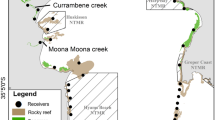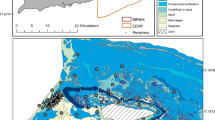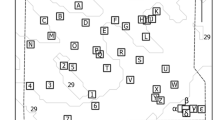Abstract
Acoustic telemetry was used to examine habitat use and movement of two sympatric gamefishes, red drum (Sciaenops ocellatus) and spotted seatrout (Cynoscion nebulosus), at two spatial scales (habitat and bay) within an estuarine complex. Habitat-scale tracking (~ 1 m–1 km) based on an acoustic positioning system revealed that seagrass was used extensively by both species. Red drum also commonly associated with oyster reef and boundaries between habitat types. Spatial overlap between the two species was limited and indicative of habitat partitioning; red drum were commonly observed in the shallow, inner lagoon and spotted seatrout in the deeper, open bay portion of the array. Conspicuous diel shifts were also observed for spotted seatrout; fish transitioned from seagrass to bare substrate and displayed greater rates of movement at night than day. Bay-scale (1–50+ km) tracking over a two-year period primarily showed limited movement within bays; however, directed bay-scale movements by both species were observed during winter and spring, when a small contingent of individuals moved up to 70 km from original tagging locations. Habitat use and movement were species specific and subject to temporal variation, both diel and seasonal. Habitat-scale connectivity was influenced by seascape structure and water depth, and bay-scale connectivity was generally limited, suggesting the sustainability of these fisheries is likely influenced by local conditions.







Similar content being viewed by others
References
Adams, D.H., and D.M. Tremain. 2000. Association of large juvenile red drum, Sciaenops ocellatus, with an estuarine creek on the Atlantic coast of Florida. Environmental Biology of Fishes 58(2): 183–194.
Afonso, P., J. Fontes, K.N. Holland, and R.S. Santos. 2009. Multi-scale patterns of habitat use in a highly mobile reef fish, the white trevally Pseudocaranx dentex, and their implications for marine reserve design. Marine Ecology Progress Series 381: 273–286.
Allen, M.C., A.J. Read, J. Gaudet, and L.S. Sayigh. 2001. Fine-scale habitat selection of foraging bottlenose dolphins Tursiops truncatus near Clearwater, Florida. Marine Ecology Progress Series 222: 253–264.
Andrews, K.S., N. Tolimieri, G.D. Williams, J.F. Samhouri, C.J. Harvey, and P.S. Levin. 2011. Comparison of fine-scale acoustic monitoring systems using home range size of a demersal fish. Marine Biology 158(10): 2377–2387.
Bacheler, N.M., L.M. Paramore, S.M. Burdick, Buckel, and J.E. Hightower. 2009. Variation in movement patterns of red drum (Sciaenops ocellatus) inferred from conventional tagging and ultrasonic telemetry. Fishery Bulletin 107(4): 405–418.
Baker, R., and M. Sheaves. 2007. Shallow-water refuge paradigm: conflicting evidence from tethering experiments in a tropical estuary. Marine Ecology Progress Series 349: 13–22.
Beck, M.W., K.L. Heck Jr., K.W. Able, D.L. Childers, D.B. Eggleston, B.M. Gillanders, B. Halpern, C.G. Hays, K. Hoshino, T.J. Minello, R.J. Orth, P.F. Sheridan, and M.P. Weinstein. 2001. The identification, conservation, and management of estuarine and marine nurseries for fish and invertebrates. Bioscience 51(8): 633–641.
Becker, A., and I.M. Suthers. 2014. Predator driven diel variation in abundance and behaviour of fish in deep and shallow habitats of an estuary. Estuarine, Coastal and Shelf Science 144: 82–88.
Brown-Peterson, N.J., M.S. Peterson, D.L. Nieland, M.D. Murphy, R.G. Taylor, and J.R. Warren. 2002. Reproductive biology of female spotted seatrout, Cynoscion nebulosus, in the Gulf of Mexico: differences among estuaries? Environmental Biology of Fishes 63(4): 405–415.
Callihan, J.L., J.H. Cowan Jr., and M.D. Harbison. 2014. Sex-specific movement response of an estuarine sciaenid (Cynoscion nebulosus) to freshets. Estuaries and Coasts 38(5): 1–13.
Conner, L.M., and B.W. Plowman. 2001. Using Euclidean distances to assess nonrandom habitat use. In Radio tracking and animal populations, 275–290. San Diego, CA: Academic Press.
Cunjak, R.A., J.M. Roussel, M.A. Gray, J.P. Dietrich, D.F. Cartwright, K.R. Munkittrick, and T.D. Jardine. 2005. Using stable isotope analysis with telemetry or mark-recapture data to identify fish movement and foraging. Oecologia 144(4): 636–646.
Dance, M.A., and J.R. Rooker. 2015. Habitat- and bay-scale connectivity of sympatric fishes in an estuarine nursery. Estuarine, Coastal and Shelf Science 167: 447–457.
Dance, M.A., and J.R. Rooker. 2016. Stage-specific variability in habitat associations of juvenile red drum across a latitudinal gradient. Marine Ecology Progress Series 557: 221–235.
Dance, M.A., D.L. Moulton, N.B. Furey, and J.R. Rooker. 2016. Does transmitter placement or species affect detection efficiency of tagged animals in biotelemetry research? Fisheries Research 183: 80–85.
Ellis, T.A. 2014. Mortality and movement of spotted seatrout at its northern latitudinal limits. PhD dissertation. North Carolina State University. 260 p.
Espinoza, M., T.J. Farrugia, D.M. Webber, F. Smith, and C.G. Lowe. 2011a. Testing a new acoustic telemetry technique to quantify long-term, fine-scale movements of aquatic animals. Fisheries Research 108(2): 364–371.
Espinoza, M., T.J. Farrugia, and C.G. Lowe. 2011b. Habitat use, movements and site fidelity of the gray smooth-hound shark (Mustelus californicus gill 1863) in a newly restored southern California estuary. Journal of Experimental Marine Biology and Ecology 401(1): 63–74.
Facendola, J.J., and F.S. Scharf. 2012. Seasonal and ontogenetic variation in the diet and daily ration of estuarine red drum as derived from field-based estimates of gastric evacuation and consumption. Marine and Coastal Fisheries 4(1): 546–559.
Farrugia, T.J., M. Espinoza, and C.G. Lowe. 2011. Abundance, habitat use and movement patterns of the shovelnose guitarfish (Rhinobatos productus) in a restored southern California estuary. Marine and Freshwater Research 62(6): 648–657.
Flaherty-Walia, K.E., R.E. Matheson Jr., and R. Paperno. 2015. Juvenile spotted seatrout (Cynoscion nebulosus) habitat use in an eastern Gulf of Mexico estuary: the effects of seagrass bed architecture, seagrass species composition, and varying degrees of freshwater influence. Estuaries and Coasts 38(1): 353–366.
Fodrie, F.J., L.A. Yeager, J.H. Grabowski, C.A. Layman, G.D. Sherwood, and M.D. Kenworthy. 2015. Measuring individuality in habitat use across complex landscapes: approaches, constraints, and implications for assessing resource specialization. Oecologia 178(1): 75–87.
Fraser, N.H.C., and N.B. Metcalfe. 1997. The costs of becoming nocturnal: feeding efficiency in relation to light intensity in juvenile Atlantic salmon. Functional Ecology 11(3): 385–391.
Furey, N.B., M.A. Dance, and J.R. Rooker. 2013. Fine-scale movements and habitat use of juvenile southern flounder Paralichthys lethostigma in an estuarine seascape. Journal of Fish Biology 82(5): 1469–1483.
Gillanders, B.M. 2006. Seagrasses, fish, and fisheries. In Seagrasses: biology, ecology, and conservation, 503–505. Dordrecht: Springer.
Gjelland, K.Ø., and R.D. Hedger. 2013. Environmental influence on transmitter detection probability in biotelemetry: developing a general model of acoustic transmission. Methods in Ecology and Evolution 4(7): 665–674.
Grober-Dunsmore, R., S.J. Pittman, C. Caldow, M.S. Kendall, and T.K. Frazer. 2009. A landscape ecology approach for the study of ecological connectivity across tropical marine seascapes. In Ecological connectivity among tropical coastal ecosystems, 493–530. Dordrecht: Springer.
Heck, K.L. Jr., and R.J. Orth. 2006. Predation in seagrass beds. In Seagrasses: biology, ecology and conservation, 537–550. Dordrecht: Springer.
Heupel, M.R., J.M. Semmens, and A.J. Hobday. 2006. Automated acoustic tracking of aquatic animals: scales, design and deployment of listening station arrays. Marine and Freshwater Research 57(1): 1–13.
Kinney, M.J., N.E. Hussey, A.T. Fisk, A.J. Tobin, and C.A. Simpfendorfer. 2011. Communal or competitive? Stable isotope analysis provides evidence of resource partitioning within a communal shark nursery. Marine Ecology Progress Series 439: 263–276.
Knickle, D.C., and G.A. Rose. 2014. Dietary niche partitioning in sympatric gadid species in coastal Newfoundland: evidence from stomachs and CN isotopes. Environmental Biology of Fishes 97(4): 343–355.
Lanier, J.M., and F.S. Scharf. 2007. Experimental investigation of spatial and temporal variation in estuarine growth of age-0 juvenile red drum (Sciaenops ocellatus). Journal of Experimental Marine Biology and Ecology 349(1): 131–141.
Llanso, R.J., S.S. Bell, and F.E. Vose. 1998. Food habits of red drum and spotted seatrout in a restored mangrove impoundment. Estuaries 21(2): 294–306.
MacRae, P.S., and J.H. Cowan Jr. 2010. Habitat preferences of spotted seatrout, Cynoscion nebulosus, in coastal Louisiana: a step towards informing spatial management in estuarine ecosystems. The Open Fish Science Journal 3: 154–163.
McMichael, R.H., and K.M. Peters. 1989. Early life history of spotted seatrout, Cynoscion nebulosus (Pisces: Sciaenidae), in Tampa Bay, Florida. Estuaries 12(2): 98–110.
Mohan, J.A., and B.D. Walther. 2015. Spatiotemporal variation of trace elements and stable isotopes in subtropical estuaries: II. Regional, local, and seasonal salinity-element relationships. Estuaries and Coasts 38(3): 769–781.
Nagelkerken, I., M. Sheaves, R. Baker, and R.M. Connolly. 2014. The seascape nursery: a novel spatial approach to identify and manage nurseries for coastal marine fauna. Fish and Fisheries 16(2): 362–371.
Neahr, T.A., G.W. Stunz, and T.J. Minello. 2010. Habitat use patterns of newly settled spotted seatrout in estuaries of the North-Western Gulf of Mexico. Fisheries Management and Ecology 17(5): 404–413.
Nieland, D.L., R.G. Thomas, and C.A. Wilson. 2002. Age, growth, and reproduction of spotted seatrout in Barataria Bay, Louisiana. Transactions of the American Fisheries Society 131(2): 245–259.
NOAA National Estuarine Research Reserve System (NERRS). System-wide monitoring program. Data accessed from the NOAA NERRS centralized data management office website. http://cdmo.baruch.sc.edu/. Accessed 10 March 2016.
Nunn, A.D., L.H. Tewson, and T.G. Cowx. 2012. The foraging ecology of larval and juvenile fishes. Reviews in Fish Biology and Fisheries 22(2): 377–408.
Patterson, H.M., R.S. McBride, and N. Julien. 2004. Population structure of red drum (Sciaenops ocellatus) as determined by otolith chemistry. Marine Biology 144(5): 855–862.
Porch, C.E., C.A. Wilson, and D.L. Nieland. 2002. A new growth model for red drum (Sciaenops ocellatus) that accommodates seasonal and ontogenic changes in growth rates. Fishery Bulletin 100(1): 149–152.
Reebs, S.G. 2002. Plasticity of diel and circadian activity rhythms in fishes. Reviews in Fish Biology and Fisheries 12(4): 349–371.
Reese Robillard, M.M., L.M. Payne, R.R. Vega, and G.W. Stunz. 2015. Best practices for surgically implanting acoustic transmitters in spotted seatrout. Transactions of the American Fisheries Society 144(1): 81–88.
Rooker, J.R., and S.A. Holt. 1997. Utilization of subtropical seagrass meadows by newly settled red drum Sciaenops ocellatus: patterns of distribution and growth. Marine Ecology Progress Series 158: 139–149.
Rooker, J.R., S.A. Holt, M.A. Soto, and G.J. Holt. 1998a. Postsettlement patterns of habitat use by sciaenid fishes in subtropical seagrass meadows. Estuaries 21(2): 318–327.
Rooker, J.R., G.J. Holt, and S.A. Holt. 1998b. Vulnerability of newly settled red drum (Sciaenops ocellatus) to predatory fish: is early-life survival enhanced by seagrass meadows? Marine Biology 131: 145–151.
Rooker, J.R., G.W. Stunz, S.A. Holt, and T.J. Minello. 2010. Population connectivity of red drum in the northern Gulf of Mexico. Marine Ecology Progress Series 407: 187–196.
Roy, R., J. Beguin, C. Argillier, L. Tissot, F. Smith, S. Smedbol and E. De-Oliveira. 2014. Testing the VEMCO Positioning System: spatial distribution of the probability of location and the positioning error in a reservoir. Animal Biotelemetry 2(1): 1.
Scharf, F.S., and K.K. Schlicht. 2000. Feeding habits of red drum (Sciaenops ocellatus) in Galveston Bay, Texas: seasonal diet variation and predator-prey size relationships. Estuaries 23(1): 128–139.
Simpfendorfer, C.A., M.R. Heupel, and R.E. Hueter. 2002. Estimation of short-term centers of activity from an array of omnidirectional hydrophones and its use in studying animal movements. Canadian Journal of Fisheries and Aquatic Sciences 59(1): 23–32.
Stunz, G.W., T.J. Minello, and P.S. Levin. 2002. Growth of newly settled red drum Sciaenops ocellatus in different estuarine habitat types. Marine Ecology Progress Series 238: 227–236.
Werner, E.E., D.J. Hall, D.R. Laughlin, D.J. Wagner, L.A. Wilsmann, and F.C. Funk. 1977. Habitat partitioning in a freshwater fish community. Journal of the Fisheries Board of Canada 34(3): 360–370.
Werner, E.E., G.G. Mittelbach, D.J. Hall and J.F. Gilliam. 1983. Experimental tests of optimal habitat use in fish: the role of relative habitat profitability. Ecology 64(6): 1525–1539.
Wilson, C.A., and D.L. Nieland. 1994. Reproductive biology of red drum, Sciaenops ocellatus, from the neritic waters of the northern Gulf of Mexico. Fishery Bulletin 92(4): 841–850.
Wilson, C.J., P.S. Wilson, C.A. Greene, and K.H. Dunton. 2013. Seagrass meadows provide an acoustic refuge for estuarine fish. Marine Ecology Progress Series 472: 117–127.
Acknowledgements
The authors would like to thank members of the Fisheries Ecology Lab at TAMUG and Center for Sportfish Science and Conservation at TAMU-CC for assistance in the lab and field. This publication was supported in part by an Institutional Grant from the Texas Sea Grant College Program from the National Sea Grant Office, National Oceanic and Atmospheric Administration, U.S. Department of Commerce (NA10OAR4170099 to JRR). Additional funding was provided by the McDaniel Charitable Foundation (JRR) and the Harte Research Institute (GWS). The manuscript was improved by the comments of two anonymous reviewers.
Author information
Authors and Affiliations
Corresponding author
Additional information
Communicated by Charles Simenstad
Rights and permissions
About this article
Cite this article
Moulton, D.L., Dance, M.A., Williams, J.A. et al. Habitat Partitioning and Seasonal Movement of Red Drum and Spotted Seatrout. Estuaries and Coasts 40, 905–916 (2017). https://doi.org/10.1007/s12237-016-0189-7
Received:
Revised:
Accepted:
Published:
Issue Date:
DOI: https://doi.org/10.1007/s12237-016-0189-7




